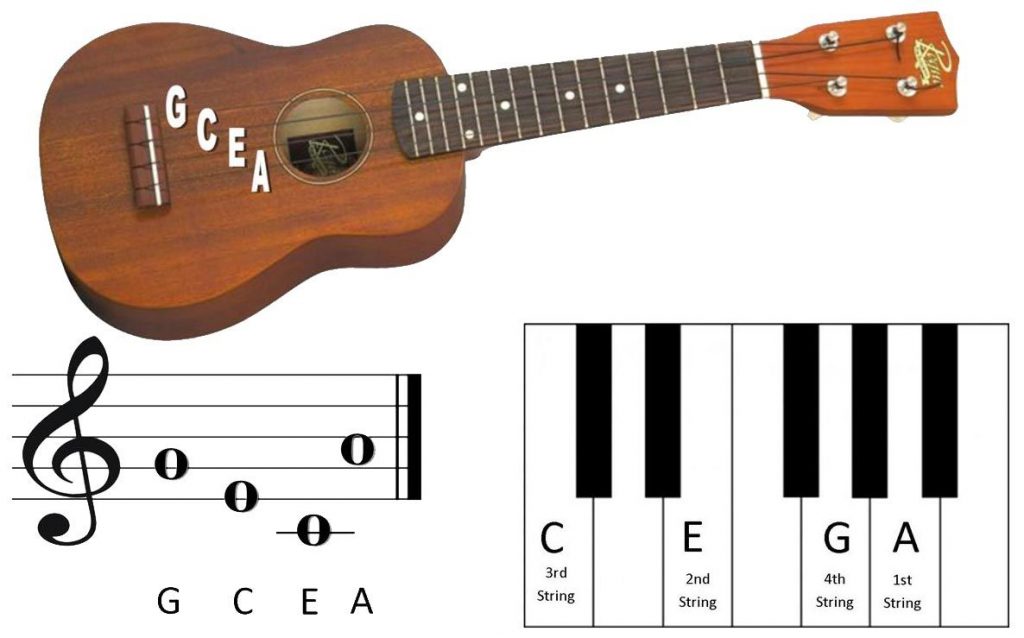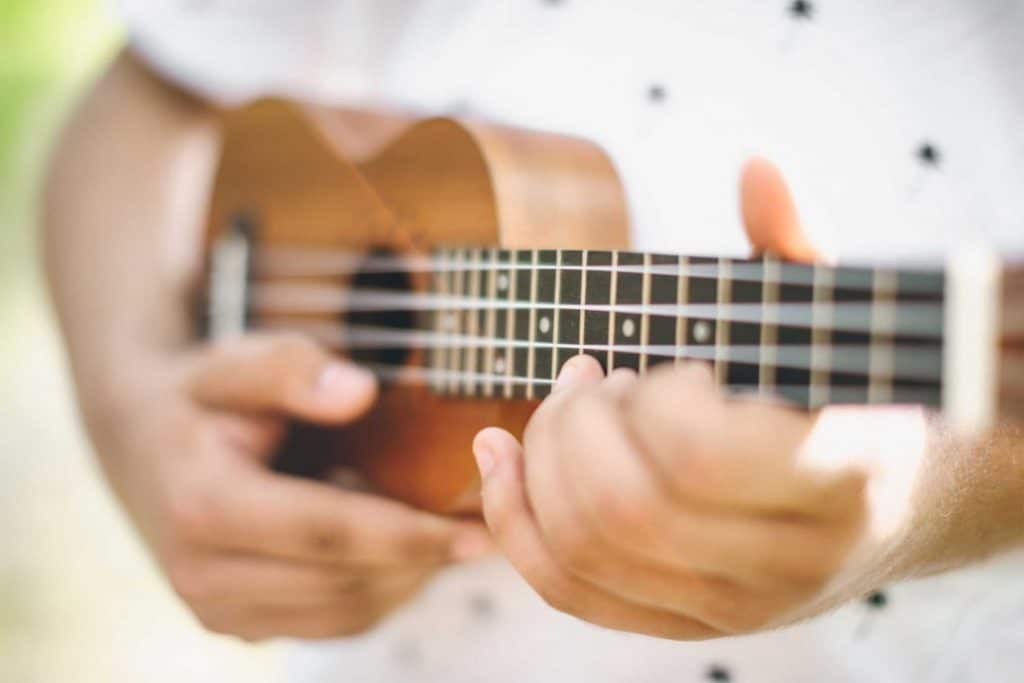The ukulele is a wonderful instrument and underrated by many. It’s not too hard to play, and you’ll be making joyful sounds in no time at all. It’s great for playing songs and can be a perfect setting for many enjoyable social occasions.
In this guide, we’ll show you how to choose a ukulele, tune it, and to hold it properly. After that, we’ll go through how to play the chords with plenty of useful tips. Once you’ve finished reading, you’ll no longer be asking how to play the ukulele.

In order to play the ukulele, you first need to go out and get one! Here, we’ll look at what you should be looking for and which brands are the best to try.
When you just start out with an instrument, you don’t want to get a premium range model as you’re not going to be great at first, you may not enjoy it, and its quality may be wasted until you start to improve.
That being said, you don’t want a cheap and nasty ukulele either, as these won’t have a great sound quality and can be more difficult to play.
It’s also a good idea to pick up a ukulele from a reputable brand. Kala, Mahalo, Lanikai, Makala, Kamaka, Luna, and Kanilea are all good brands that make excellent beginner models. There are other great brands out there, but make sure you do your research. You don’t need an amazing ukulele to start with, but you at least want a good one.
If you’ve ever played a string instrument before, you’ll know all about the importance of tuning. For those that haven’t, this is where you will need to either tighten or loosen a string until it hits the right tone.
With a ukulele, the standard tuning is G-C-E-A from the top string to the bottom. Tuning can be tough, and it can involve knowing the notes by ear or using a tuned instrument such as a piano to find the right notes.

There are, of course, simpler methods. You can make your life easier by getting a high-quality electric tuner, but while you are waiting for that to arrive, there are also online tuners that will use your microphone to tune your ukulele.
It’s always the best idea to learn how to do it manually, as there may be no access to an electronic tuner at the moment.
This may seem like an obvious thing to know, but ukulele’s don’t have straps in the same way that guitars do, you can’t stand them up like a double-bass, and you don’t have the chin rest as you would with a violin.
So how do you hold it? When you’re sitting down, this is not going to be an issue. You can simply rest the ukulele on your leg and strum along to it. It’s best to rest your forearm on the top of the ukulele, which will keep it nicely in place.
When you are standing, your strumming hand needs to cradle the ukulele. To keep the ukulele in position, you then press it against your chest with your forearm. You don’t need to do this too tightly as the ukulele will be quite light.
With your left hand, you want to place the ukulele in the gap between your thumb and index finger. Your thumb will always be resting on the back of the neck while you’re making chord shapes with your fingers on the other side.

If you have never strummed an instrument before, you’ll probably think that it looks really easy. In reality, it can be infuriating at first, as it’s difficult to make perfect contact with all four strings. It’s best to begin slow, then pick up the pace as you start to get to grips with it.
A lot of ukulele chords are very simple to play. The C chord, for example, only requires you to press down on one string. This is a great starting point. This C chord is played by pressing down the bottom string on the third fret.
In order to leave your other fingers open for playing different chords, it’s best to play this C chord with your ring finger. The top three strings are left open, and you strum every one of them so they should be fairly loud and clear.
If your fingers start to get sore then don’t worry, that happens to everyone. Your thumb gets used to strumming, but your fingertip may take longer to adjust. Eventually, they will have calluses that will stop any pain.
So you’ve mastered the C chord, now it’s time for the rest. There are hundreds of different chords, but the first ones you want to master are the A, B, C, D, E, F, and G major chords, as this will give you a great grounding to play the rest of them. If you’re wondering how to play E on the ukulele, for example, this would involve the top three stings pressed down on the 4th fret and the bottom note pressed down on the 2nd fret.
When you get a chord tab, you’ll have a visual representation of a fretboard from a top-down view: with the top string represented on the left, over to the bottom of the string on the right. On this diagram, there will be some black dots. These dots represent where your finger needs to be placed.
The top line of the tab shows the top of the fretboard with the lines across, telling you where the frets are on the neck of the ukulele. When playing a chord, you need to place your finger in the middle of the two frets, not directly on top of them.
With chord positions, use your index and middle finger on the top two strings and your little finger and ring finger on the bottom two. This isn’t always the case (such as a G chord), but you just want to make sure that you’re in the most comfortable position.

At the start, it’s great to find songs that only have the chords of C, Am, F, and G. This is because the C and Am chord only require pressure on one string, the F is two, and the G has three but is a great learning chord.
C = Bottom string, 3rd fret
Am = Top strings, 3nd fret
F = 3rd string, 1st fret & Top sting, 2nd feet
G = 2nd string, 2nd fret & 3rd sting, 3rd fret & Bottom string, 2nd fret
Let’s look at how to play easy songs on the ukulele:
A great song to start with is “Let It Be” by The Beatles, which you can play with these four chords. There are many other great examples out there to try, but with this being such a well-known song, you’ll pick it up straight away.
In terms of the strumming pattern, it’s best at the start to concentrate on the down strokes and strum your ukulele on the downbeat. This will get you used to strumming, and as you get better, you can start to experiment with different strumming patterns.
There are many great tabs Trusted Source Play Thousands of Easy Ukulele Songs with 3, 4, or 5 Chords This is the definitive collection of easy ukulele songs. You can choose from thousands of beginner tunes – all which only use 3, 4, or 5 simple chords. www.chordgenome.com out there that are going to get you started on your journey to becoming a world-class ukulele player. Here, we will look at a few other great options to get you started:
Over The Rainbow by Israel Kamakawiwo’ole
Trying to play Israel Kamakawiwo’ole’s version of this classic is a lot easier than trying to pronounce his name! This song is great at helping you to develop your strumming patterns.
Riptide by Vance Joy
Not many pop songs use ukulele in their original version, which makes this song a must-learn. This will help you to learn how to play quicker and also develop the art of singing and playing at the same time.
Love Yourself by Justin Bieber
This is a brilliant song to learn with, as you can play it very slow at the start with simple strumming before adding in more complex strumming patterns as you get more confident.
This is only a very small selection of songs, but, thankfully, there are amazing resources out there that give you access to thousands of tabs and notes. It’s best to master one of these simple songs at the start before moving on to something a little more complicated.

Play it loose – It’s tempting at the start to press down hard on the chords, hammer the strings with your thumb and tightly press the ukulele into your chest with the arm. Instead, play as loose as you can, and it will cause less strain and will sound better.
Changing chords – Changing chords will feel clunky at first. After a while, you’ll learn how to smoothly transition your fingers and keep them pressed the same way with each chord. Try to learn to change the chord between strumming strokes to make it sound correct.
Play along – It can be hard sometimes to know if what you’re doing is right. It’s always a good idea just to stick on a video and play along. This will give you a perfect idea of how it’s meant to sound.
Finger pain – Finger pain is inevitable for a beginner. Make sure that you’re not pressing too hard on the strings. Also, although it may be tempting, leave your calluses alone! They need to build up. A good trick is to grip a credit card (or similar) with one side on your palm, and the other pressed into your palm by your fingertips. This will help you to develop calluses quickly.
This is a great introduction to the world of how to play the ukulele for beginners. Hopefully, now you have all the building blocks you need to start playing chords. Take your time and try not to rush it as otherwise, you can get frustrated.
Make sure you don’t get disheartened as you will soon be playing complex strumming patterns, hundreds of chords, and wowing the crowd. The ukulele is a lovely instrument, and with these tips, you’ll soon be able to play it.